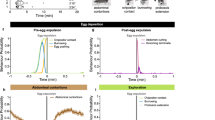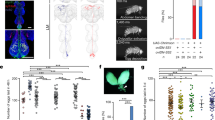Abstract
TheAplysia neuroendocrine system is a particularly advantageous model for cellular and molecular studies because of the relatively small number and large size of its component neurons. In addition, numerous anatomical and physiological studies have resulted in the assignment of behavioral roles to individual identified neurons. Recombinant DNA techniques have been used to isolate the genes that encode the precursors of peptides involved in egg-laying behavior. The comparison of the egg-laying hormone (ELH) gene family within the genusAplysia reveals high homologies in the overall structure of the precursors. A well-conserved tetrabasic residue has been shown to be the first endoproteolytic cleavage site of the precursor, giving rise to two intermediates, which are differentially processed and packaged. Some members of the ELH gene family are expressed specifically in the bag cell clusters or the atrial gland, respectively, providing an opportunity to study control of gene expression at the molecular level.
Similar content being viewed by others
References
Arch, S., and Smock, T. (1977). Egg-laying behavior inAplysia californica.Behav. Biol. 19: 45–54.
Arch, S., Lupatkin, J., Smock, T., and Beard, M. (1980). Evidence for an exocrine function of theAplysia atrial gland.J. Comp. Physiol. 140:131–137.
Berry, R. W. (1982). Seasonal modulation of synthesis of the neurosecretory egg-laying hormone ofAplysia.J. Neurobiol. 13:327–335.
Berry, R. W. (1986). Calcium and protein kinase C inhibits biosynthesis ofAplysia egg-laying hormone.Brain Res. 387:185–187.
Bruehl, C. L., and Berry, R. W. (1985). Regulation of synthesis of the neurosecretory egg-laying hormone ofAplysia: antagonistic roles of calcium and cyclic adenosine 3′:5′-monophosphate.J. Neurosci. 5:1233–1238.
Chiu, A. Y., and Strumwasser, F. (1984). Two neuronal populations in the head ganglia ofAplysia californica with egg-laying hormone-like immunoreactivity.Brain Res. 294:83–93.
Chiu, A. Y., Hunkapiller, M. W., Heller, E. W., Stuart, D. K., Hood, L. E., and Strumwasser, F. (1979). Neuropeptide egg-laying hormone ofAplysia californica: purification and primary structure.Proc. Natl. Acad. Sci. 76:6656–6660.
DesGroseillers, L., and Scheller, R. H. (1988). Molecular biology and physiology ofAplysia neuropeptides. InMolecular Biology of Brain and Endocrine Peptidergic System, Plenum, New York, pp. 299–313.
DesGroseillers, L., Cowan, D., Miles, M., Sweet, A., and Scheller, R. H. (1987).Aplysia californica neurons express microinjected neuropeptide genes.Mol. Cell. Biol. 7:2762–2771.
Fisher, J. M., Sossin, W., Newcomb, R., and Scheller, R. H. (1988). Multiple neuropeptides derived from a common precursor are differentially packaged and transported.Cell 54:813–822.
Heller, E., Kaczmarek, L. K., Hunkapiller, M. W., Hood, L. E., and Strumwasser, F. (1980). Purification and primary structure of two neuroactive peptides that cause bag cell after discharge and egg-laying inAplysia.Proc. Natl. Acad. Sci. 77:2328–2332.
Joosse, J., Ebberink, R. H. M., Geraerts, M., Jansen, R. F., and TerMaat, A. (1985). The caudodorsal cells ofLymnaea stigmalis: primary structure of the ovulation hormone and biosynthesis and role of multiple peptides released during egg laying. In Kobayahi, H., et al. (eds.),Neurosecretion and the Biology of Neuropeptides, Jap. Sci. Soc. Press, Tokyo, pp. 50–59.
Kaldany, R.-R. J., Nambu, J. R., and Scheller, R. H. (1985). Neuropeptides in identifiedAplysia neurons.Annu. Rev. Neurosci. 8:431–455.
Kandel, E. R. (1976).Cellular Basis of Behavior, W. H. Freeman, San Francisco.
Kandel, E. R. (1979).Behavioral Biology of Aplysia, W. H. Freeman, San Francisco.
Kirk, M. D., Taussig, R., and Scheller, R. H. (1988). Egg-laying hormone, serotonin, and cyclic nucleotide modulation of ionic currents in the identified motoneuron B16 ofAplysia.J. Neurosci. 8:1181–1193.
Kreiner, T., Rothbard, J. B., Schoolnik, G. K., and Scheller, R. H. (1984). Antibodies to synthetic peptides defined by cDNA cloning reveal a network of peptidergic neurons inAplysia.J. Neurosci. 4:2581–2589.
Kupfermann, I. (1967). Stimulation of egg-laying. Possible neuroendocrine function of bag cells of abdominal ganglion ofAplysia californica.Nature 216:814–815.
Levitan, E. S., Kramer, R. H., and Levitan, I. B. (1987). Augmentation of bursting pacemaker activity by egg-laying hormone inAplysia neuron R15 is mediated by a cyclic AMP-dependent increase in Calcium and Potassium currents.Proc. Natl. Acad. Sci. 84:6307–6311.
MacGinitie, G. E. (1934). The egg-laying activities of the sea hare,Tethys californicus.Biol. Bull. Woods Hole 67:300–303.
Mahon, A. C., Nambu, J. R., Taussig, R., Shyamala, M., Roach, A., and Scheller, R. H. (1985). Structure and expression of the egg-laying hormone gene family inAplysia.J. Neurosci. 5:1872–1880.
McAllister, L. B., Scheller, R. H., Kandel, E. R., and Axel, R. (1983). In situ hybridization to study the origin and fate of identified neurons.Science 222:800–808.
Mayeri, E., Brownell, P. H., Branton, W. D., and Simon, S. B. (1979a). Multiple, prolonged actions of neuroendocrine bag cells on neurons inAplysia. I. Effects on bursting pacemaker neurons.J. Neurophysiol. 42:1165–1184.
Mayeri, E., Brownell, P. H., and Branton, W. D. (1979b). Multiple prolonged actions of neuroendocrine bag cells on neurons inAplysia. II. Effects on beating pacemaker and silent neurons.J. Neurophysiol. 42:1185–1197.
Mayeri, E., Rothman, B. S., Brownell, P. H., Branton, W. D., and Padgett, L. (1985). Nonsynaptic characteristics of neurotransmission mediated by egg-laying hormone in the abdominal ganglion ofAplysia.J. Neurosci. 5:2060–2077.
Nagle, G. T., Painter, S. D., Blankenship, J. E., Dixon, J. D., and Kurosky, A. (1986) Evidence for the expression of three genes encoding homologous atrial gland peptides that cause egg-laying inAplysia.J. Biol. Chem. 261:7853–7859.
Nagle, G. T., Painter, S. D., Blankenship, J. E., and Kurosky, A. (1988). Proteolytic processing of egg-laying hormone-related precursors inAplysia. Identification of peptide regions critical for biological activity.J. Biol. Chem. 263:9223–9237.
Nambu, J. R., and Scheller, R. H. (1986). Egg-laying hormone genes ofAplysia: evolution of the ELH gene family.J. Neurosci. 6:2026–2036.
Nambu, J. R., Taussig, R., Mahon, A. C., and Scheller, R. H. (1983). Gene isolation with cDNA probes from identified Aplysia neurons: Neuropeptide modulators of cardiovascular physiology.Cell 35:47–56.
Newcomb, R., and Scheller, R. H. (1987). Proteolytic processing of theAplysia egg-laying hormone and R3-14 neuropeptide precursors.J. Neurosci. 7:854–863.
Newcomb, R., Fisher, J. M., and Scheller, R. H. (1988). Processing of the egg-laying hormone (ELH) precursor in the bag cell neurons ofAplysia.J. Biol. Chem. 263:12514–12521.
Pinsker, M., and Dudek, F. E. (1977). Bag cell control of egg-laying in freely behavingAplysia.Science 197:490–493.
Ram, J. L. (1983a). Gastropod egg-laying hormones. In Lever, J., and Boer, H. H. (eds.),Molluscan Neuroendocrinology, North-Holland, Amsterdam, pp. 94–100.
Ram, J. L. (1983b). Neuropeptide activation of an identifiable buccal ganglion motoneuron inAplysia.Brain Res. 288:177–186.
Rothman, B. S., Weir, G., and Dudek, F. E. (1983). Direct action of egg laying hormone on ovotestis ofAplysia.Gen. Comp. Endocrinol. 52:134–141.
Rothman, B. S., Mayeri, E., and Scheller, R. H. (1985). The bag cell neurons ofAplysia as a possible peptidergic multitransmitter system: From genes to behavior. In Zomzely-Neurath, C., and Walker, W. A. (eds.),Gene Expression in Brain, Wiley & Sons, New York, pp. 235–274.
Rothman, B. S., Hawke, D. H., Brown, R. O., Lee, T. D., Dehghan, A. A., Shively, J. E., and Mayeri, E. (1986). Isolation and primary structure of the califins, three biologically active egg-laying hormone-like peptides from the atrial gland ofAplysia californica.J. Biol. Chem. 261:1616–1623.
Scheller, R. H. (1985). Gene expression inAplysia peptidergic neurons. In Edelman, G. M., Gall, W. E. and Cowan, W. M. (eds.),Molecular Bases of Neural Development, Neurosciences Research Foundation, New York, pp. 513–529.
Scheller, R. H., and Kirk, M. D. (1987).Aplysia neuropeptides: A molecular genetic, biochemical and physiological analysis.Trends Neurosci. 10:46–52.
Scheller, R. H., Jackson, J. F., McAllister, L. B., Schwartz, J. H., Kandel, E. R., and Axel, R. (1982). A family of genes that codes for ELH, a neuropeptide eliciting a stereotyped pattern of behavior inAplysia.Cell 28:707–719.
Scheller, R. H., Jackson, J. F., McAllister, L. B., Rothman, B. S., Mayeri, E., and Axel, R. (1983a). A single gene encodes multiple neuroactive peptides mediating a stereotyped behavior.Cell 35:7–22.
Scheller, R. H., Rothman, B. S., and Mayeri, E. (1983b). A single gene encodes multiple peptide transmitter candidates involved in a stereotyped behavior.Trends Neurosci. 6:340–345.
Schlesinger, D. H., Babirak, S. P., and Blankenship, J. E. (1981). Primary structure of an egg laying peptide from the atrial gland ofAplysia californica. In Schlesinger, D. H. (eds.),Neurohypophyseal Peptide Hormones and Other Biologically Active Peptides, Elsevier/North-Holland, New York, pp. 137–150.
Shyamala, M., Nambu, J. R., and Scheller, R. H. (1986). Expression of egg-laying hormone gene family in the head ganglion ofAplysia.Brain Res. 371:49–57.
Sigvardt, K. A., Rothman, B. S., Brown, R. O., and Mayeri, E. (1986). The bag cells ofAplysia as a multitransmitter system: Identification of alpha bag cell peptide as a second neurotransmitter.J. Neurosci. 6:803–813.
Stuart, D. K., and Strumwasser, F. (1980). Neuronal sites of action of a neurosecretory peptide, egg-laying hormone, inAplysia californica.J. Neurophysiol. 43:499–519.
Strumwasser, F., Jacklet, J. W., and Alvarez, R. B. (1969). A seasonal rhythm in the neural extract induction of behavioral egg-laying inAplysia.Comp. Biochem. Physiol. 29:197–206.
Susswein, A. J. (1984). Identification of two stimuli regulating sexual behavior inAplysia. Meeting of the International Union of Physiological Sciences, abstract.
Toevs, L. A., and Brackenbury, R. W. (1969). Bag cell-specific proteins and the humoral control of egg-laying inAplysia californica.Comp. Biochem. Physiol. 29:207–216.
Author information
Authors and Affiliations
Rights and permissions
About this article
Cite this article
DesGroseillers, L. Molecular aspects of egg-laying behavior inAplysia californica . Behav Genet 20, 251–264 (1990). https://doi.org/10.1007/BF01067793
Issue Date:
DOI: https://doi.org/10.1007/BF01067793




